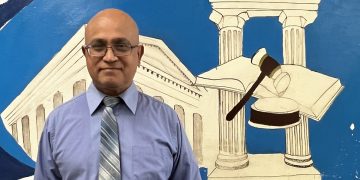501 years ago, Babur, from Central Asia -Ubekisthan today -invaded India. Defeating the local rulers, Babur established the Moghul Dynasty that went on to rule northern India for more than two hundred and thirty years.
During the long reign of Islam, from 722 AD until 1750 more than 40,000 mandirs were demolished and converted to mosques according to Sita Ram Goel in his book ‘Hindu Temples: What happened to them.’ The murtis were taken and planted beneath the steps of mosques so that the devout can trample on them. Hindus always resisted the invaders from day one with millions dying in the process.
Islam had an easy run in the Middle East conquering Iran, Iraq, Egypt etc. in less than 20 years but when it came to India Hindus never surrendered. Will Durant, an American historian, wrote: “ The Islamic invasion of India is probably the bloodiest story in history. It is a discouraging tale, for its evident moral is that civilization is a precious good, whose delicate complex of order and freedom, culture and peace, can at any moment be overthrown by barbarians invading from without and multiplying from within.”
As for the Babri Majid that replaced the demolished Ramjanmabhoomi Mandir at Ayodhya, Hindus never accepted it. Devotees continued to light deeyas on the site and fought numerous battles with millions losing their lives. During the British rule petitions were filed before the courts to have the disputed site return to the Hindus.
With the coming of Independence in 1947 and the partitioning of the country to give Muslims the nation state of Pakistan, Hindus were hopeful that the disputed Ramjanmabhoomi site would be returned to them. Unfortunately, it was not to be as the Congress government, in its haste for power, began a culture of vote bank politics, that is, appeasing the minority Muslim population for electoral support.
The opening of the Somnath Mandir in Gujarat, brought out the contempt the Congress Party and Jawaharlal Nehru, the first Prime Minister of India, had for Hindus civilization.
After being looted and razed to the ground by Mohammed Ghazni in 1299, the Somnath Mandir was rebuilt only to be destroyed again in 1394, rebuilt and again destroyed by Aurangzeb in 1706. However when it was rebuilt and scheduled for re-opening in 1951, then Prime Minister Jawarharlal Nehru protested that it would spark Hindu revivalism. He wrote a letter to the then President of India, Rajindra Prasad, asking him not to attend the opening ceremony which the latter defied.
The Bharatiya Janata Party (BJP) has unapologetically identified with the restoration of the Ramjanmabhoomi. Prime Minister Narendra Modi has been in the forefront of this movement long before his election as Prime Minister in 2014.
The enemies of Hindu dharma include not only the fundamentalist Muslims, Christians, and Communists but also opportunist Hindus who promote a brand of secularism which denies Hindus their rights while appeasing minorities – Muslims and Christians. Division of the Hindu votes has kept the Hindu majority out of power and positioned them at the mercy of their enemies.
The Bharatiya Janata Party (BJP), the Vishwa Hindu Parishad (VHP) and the Rastriya Swayamsevak Sangh (RSS) have been successful in consolidating the Hindu votes much to the detriment of the of Congress Party which is in fast decline.
The resistance to the Hindu reclamation of the Ramjammabhoomi Mandir did not come from the the Muslim minority only but also from the communists who provided intellectual arguments to distort facts and demonize the Hindus. The Congress Party, exploiting all its options went on to hire two dozen legal minds to deny that a mandir ever existed at the disputed site. Congress politicians argued that Ram was a myth. Thanks to legal minds headed by Vishnu Jain, the Hindus, armed with scientific evidence from the Archeological Society of India, presented a fool proof case that resulted in the Supreme Court of India ruling in favor of the Hindus.
As Caribbean Hindus, we have much to learn from the inauguration of the Ram Mandir. Are our politicians working in the best interest of the Hindu community? If not, then they must be replaced by those who are ready to seek our interest and welfare.
Hindus need to work together to get maximum outputs. We need to unite and demonstrate solidarity if we have to tackle social issues such as alcoholism, single parenthood, poverty, illiteracy, diabetes, State discrimination in the distribution of resources including employment and promotions etc.
Mandirs need to work together and not exist in isolation. The reality is that there are many Baburs who are acting covertly to destroy our dharma. We must awaken the Ram in us who was an empowering figure, all embracing and one who never allowed his ego to get the better of him.
Jai Sri Ram





































































